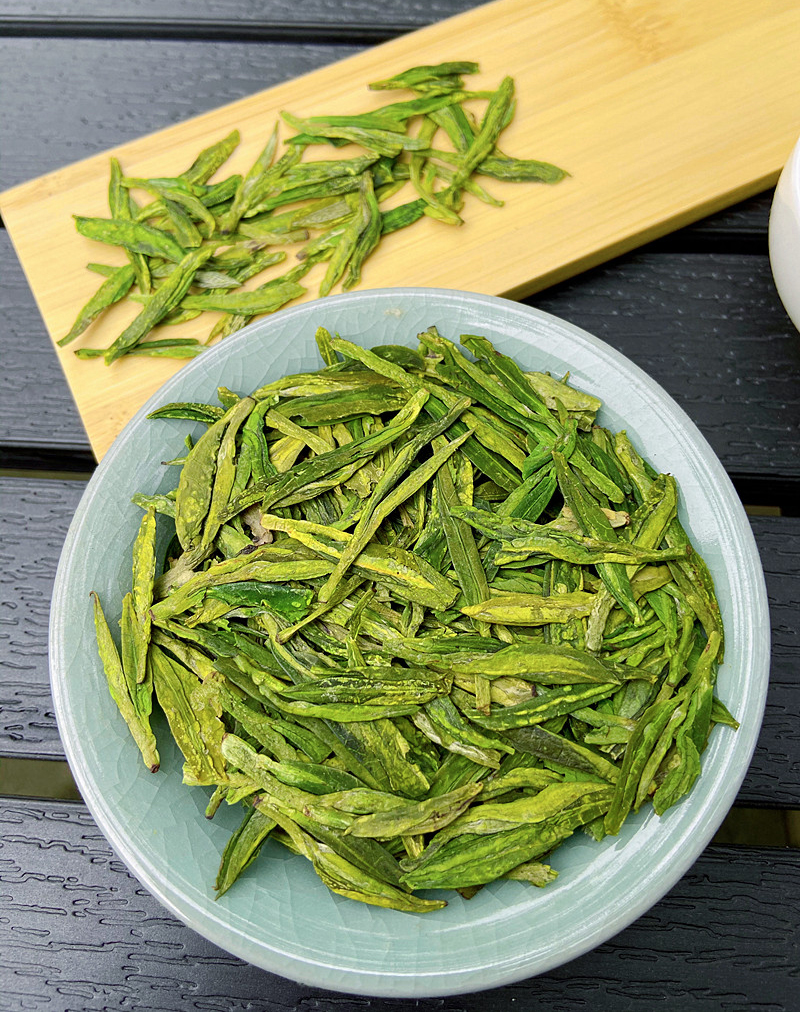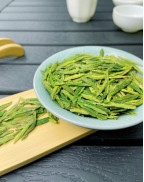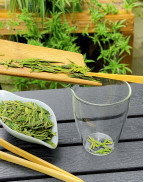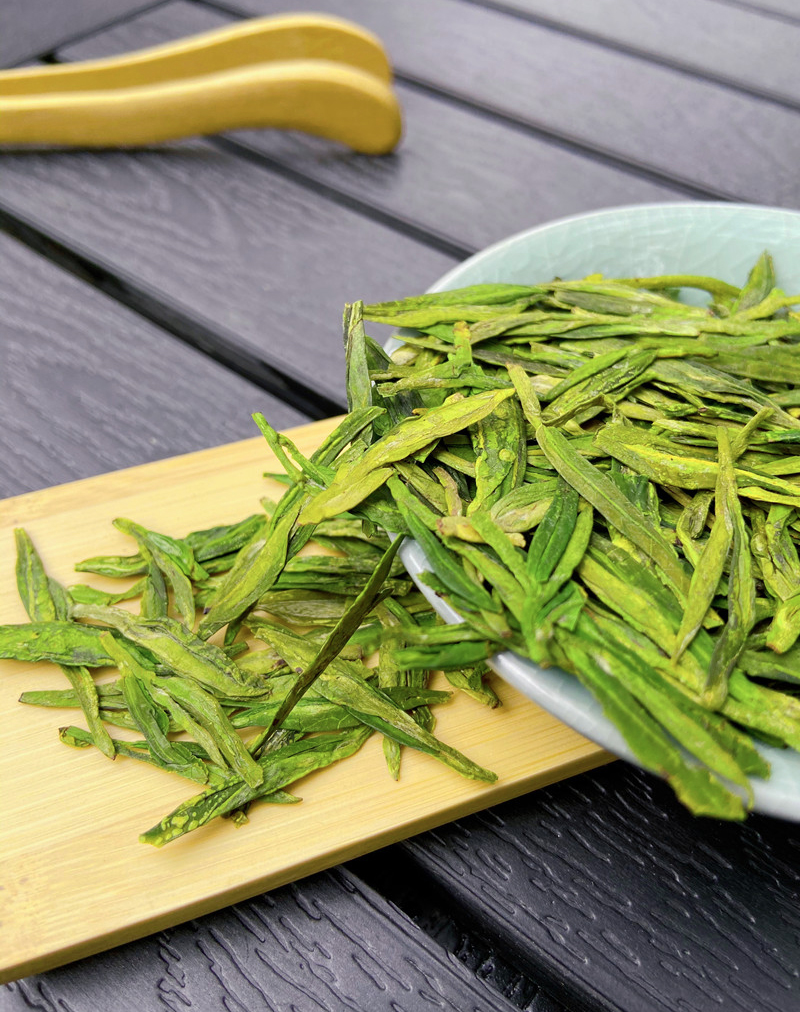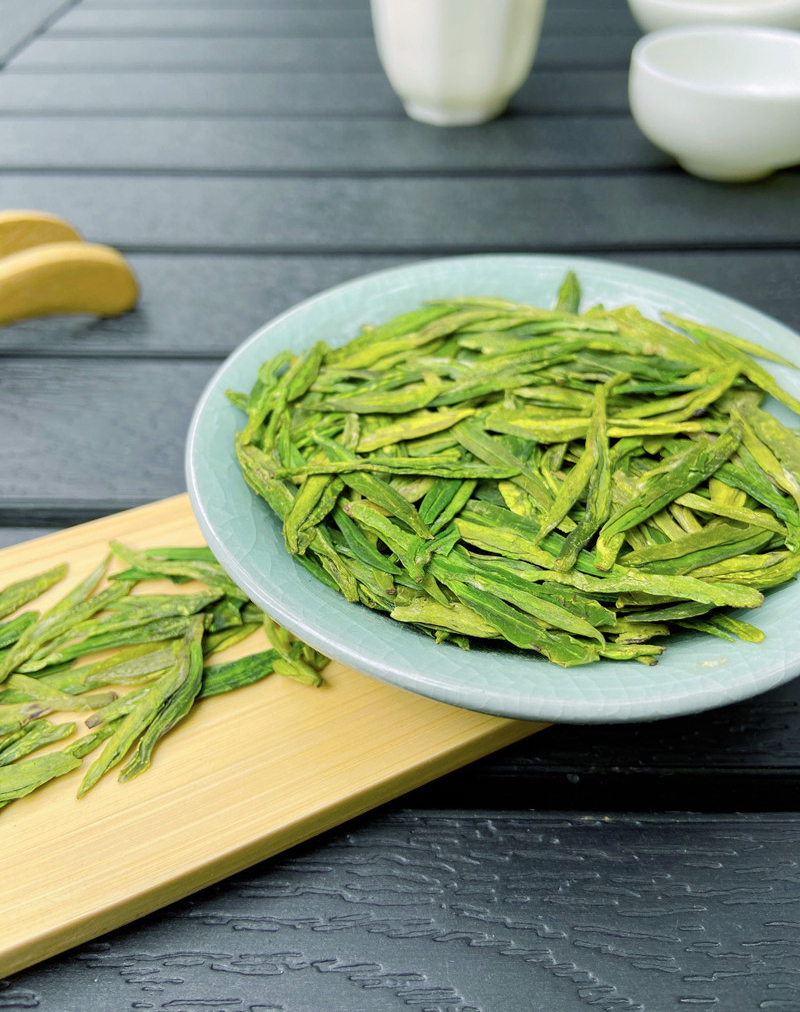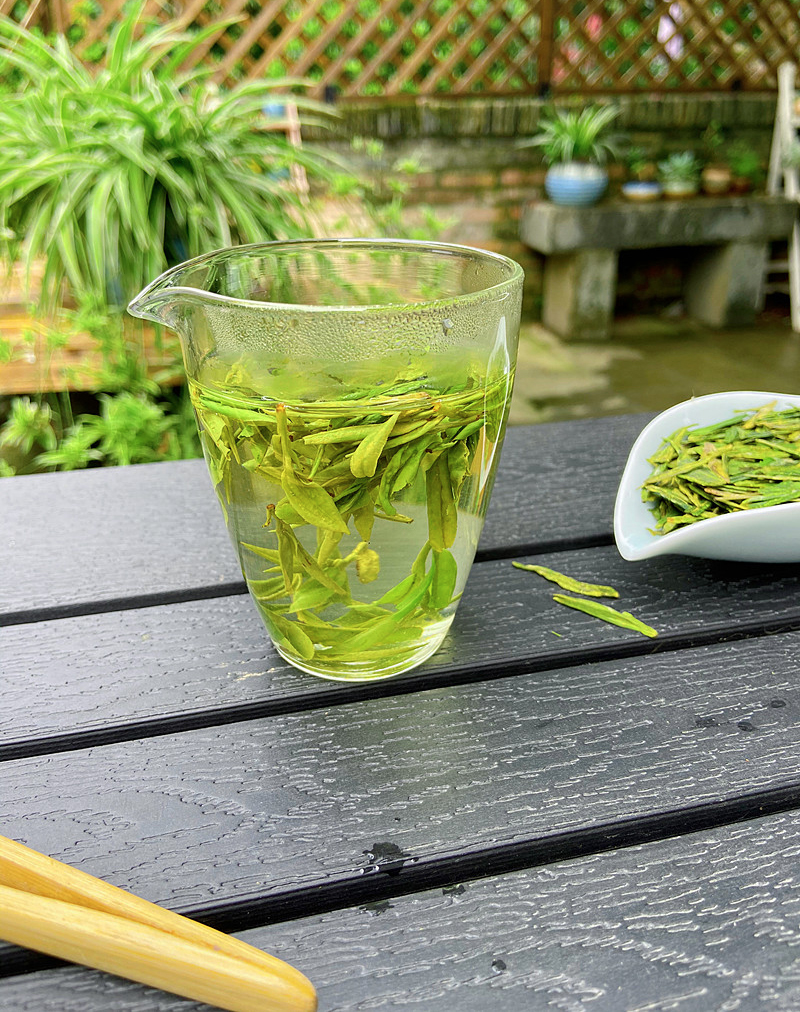Long Jing Ming Qian Dragon Well Green Tea
- Product Code: Simple
- Availability: In Stock
Basic Info
Name: Long Jing Ming Qian Dragon Well
Other Names:Dragon Well Tea, Long Jing West Lake Dragon Well, Dragon Well Green Tea
Origin: Hangzhou, Zhejiang
Season: Spring tea
Harvest Period: April 5, 2024 (First Flush)
Taste & Aroma: Highly refreshing, bitter subtleties and roasted chestnut aroma, sweet aftertaste
Item Form: Loose leaves
Tea Bush: Longjing #43
Dry Leaf: Flat, uniformly sized, fresh green
Liquor: Yellowish,clear and bright
Ingredients: Hand-picked natural tea buds and leaves
Storage: Stored in cool, airtight, opaque containers - refrigeration is recommended.
Flavor: Unflavored
Caffeine: Low
Shelf Life: 10 months at room temperature / 18 months with low temperature storage
Long Jing Ming Qian Dragon Well Green Tea
The brief history of Longjing
Longjing green tea, also known as Dragonwell tea, is a type of Chinese green tea with a rich and fascinating
history. It is one of the most famous teas in China, and has been enjoyed by tea lovers for over a thousand
years. Longjing tea is characterized by its flat, smooth and straight appearance and light-green with luster
color. It tastes fresh and mellow, the stewed leaves are tender and elastic. The tea was so highly prized that
it was even used as a form of currency and as a gift for diplomats and dignitaries.
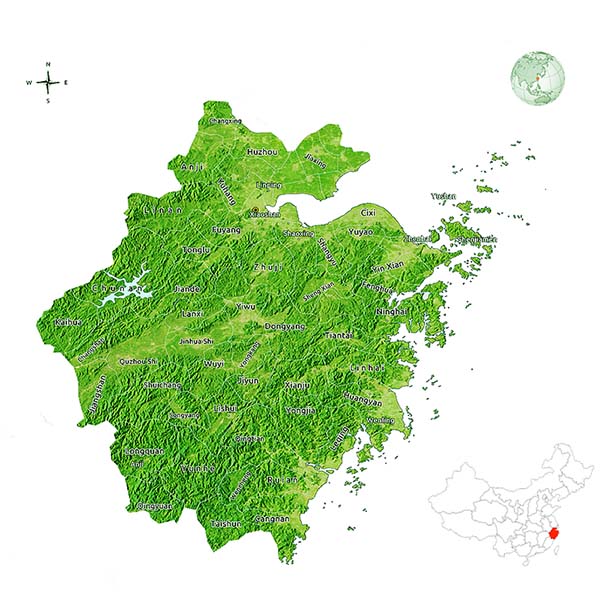
Map of Zhejiang, China
Show Full Description
The Brief History Of Longjing Tea
Longjing is a kind of green tea and one of China's top ten famous teas. It is named Longjing tea because it is
produced in the mountains around Longjing Village of West Lake in Hangzhou City, Zhejiang Province.
Longjing tea has a long history, which can be traced back to the Tang Dynasty (618-907) of China for more than 1,200 years.
In the Tang Dynasty (618-907), Lu Yu, a famous tea scholar (Tea Sage) who studied tea at that time, recorded in his first tea monograph "The Classic of Tea" that Longjing tea was produced in Hangzhou Tianzhu and Lingyin temples.
During his visit to Hangzhou's West Lake, Emperor Qianlong (1711 – 1799) of the Qing Dynasty (1636–1912) praised Longjing Tea in West Lake and sealed "The Eighteen Royal Longjing Tea Trees" in front of Hugong Temple at the foot of Lion Peak Mountain as "Royal Tea".
During the Republic of China, the well-known Longjing tea became the first of the famous teas in China. After the founding of New China, the state actively supported the development of Longjing Tea, which was listed as a national diplomatic gift tea. With the help of the local government, people in tea-growing areas promoted advanced planting and production technology, and at the same time actively improved production technology, cultivated new varieties of Longjing tea, and specially formulated the grading standard of Longjing tea. Since then, Longjing tea has had its own scientific production standards.
Today, Longjing green tea is still one of the most famous teas in China, and is enjoyed by tea lovers all over
the world.

The Eighteen Royal Longjing Tea Trees
How many types of Longjing green tea are there?
Longjing tea can be divided into Yuexiang Longjing, Dafu Longjing, Xihu Longjing, Shifeng Longjing, Meiwu Longjing, Yunqi Longjing, Huba Longjing, etc. Longjing tea is a treasure among teas. Xihu Longjing Tea is famous for its green color, fragrance, taste and beautiful shape.
According to the different tea varieties, it can be divided into eight varieties, such as Longjing 43, Pingyang Tezao, Dafu Bailongjing, Yingshuang, Zhenong 117, Zhenong 139 and Wuluniu Zao, each with its own unique characteristics. Some of the most well-known and highly-regarded types include:
Xi Hu Long Jing: This is the most famous and sought-after type of Long Jing, grown in the West Lake area of Hangzhou in Zhejiang Province. It is known for its flat, pointed leaves that are pale green in color and give off a delicate aroma.
Shi Feng Long Jing: Grown in the mountains of Zhejiang Province, this type of Long Jing has a more complex flavor profile with a subtle floral note.
Mei Jia Wu Long Jing: Grown in the mountains near West Lake, this type of Long Jing has a rich, vegetal taste and a strong fragrance.
Yun Qi Long Jing: Grown in the Yunqi area near West Lake, this type of Long Jing has a lighter, more refreshing taste with a subtle sweetness.

Longjing Tea Mountain somewhere in Hangzhou
What are the Ming Qian Long Jing and She Qian Long Jing?
Ming Qian Long Jing, also known as Pre-Qingming Long Jing, is harvested before the Qingming Festival (清明節), which usually falls around early April. The tea leaves are picked in early spring when they are still young and tender, and have a high concentration of nutrients and a delicate flavor. Because of the early harvest, Ming Qian Long Jing is considered to be of the highest quality and is more expensive than other types of Long Jing.
She Qian Long Jing, on the other hand, is harvested after the Qingming Festival and before the Grain Rain Festival, which usually falls around mid-April. The tea leaves are slightly more mature than those used for Ming Qian Long Jing, but still have a fresh, tender quality. She Qian Long Jing is considered to be of slightly lower quality than Ming Qian Long Jing, but is still highly prized for its smooth, mellow taste and delicate aroma.
Longjing Tea Recorded In Ancient Books
It is recorded in The Class of Tea by Lu Yu that "tea is produced in Tianzhu Temple and Lingyin Temple near Qiantang". Qiantang is the old name of Hangzhou, and Tianzhu Temple and Lingyin Temple are located near the West Lake. It can be seen that the area near West Lake in Hangzhou has been a place of tea production since ancient times.
During his tenure in Hangzhou, Su Shi, a famous writer in ancient China in the Song Dynasty, was full of praise for the local tea. According to his research, the tea trees planted in Tianzhu Temple were brought to Hangzhou from Tiantai Mountain by Xie Lingyun, a poet in the Southern Dynasties, when he translated Buddhist scriptures.
In the Yuan Dynasty, the tea produced by the West Lake Longjing was loved by more people. Yu Ji, a poet of the Yuan Dynasty, wrote a poem "Traveling to Longjing" to express his love for the West Lake Longjing tea.

Text About Longjing Tea Recorded In Ancient Books (1675)
In the Ming Dynasty, Longjing tea in the West Lake was taken out of the temple, and more and more people began to drink Longjing tea, which became a famous tea at that time.
In the "Zhezhi" during the Jiajing period of Ming Dynasty, it was recorded that "the tea produced near Hangzhou is generally not as good as Longjing tea, and Longjing tea with one bud and one leaf has the best quality, which is more precious because of its low yield".
In the Annals of Hangzhou written during the Wanli (1573-1620) period of the Ming Dynasty, it was recorded that "the quality of tea produced in a place called Old Longjing is the best".
"Qian Tang Xian Zhi", completed during the Wanli (1573-1620) of the Ming Dynasty, records that "Longjing Tea is unique in color, fragrance and taste".
A classification book "Shi Wu Gan Zhu" compiled in the 19th year of the Ming Wanli period listed more than 90 kinds of famous teas around China at that time, among which Longjing tea was ranked 21st.
Peng wrote in the Song of Tea Picking in the late Ming Dynasty, "The price of Longjing new tea is so high that people are only willing to drink it when entertaining guests."
In the Qing Dynasty, Qianlong made six trips to the South of the Yangtze River, four of which were to the Longjing production area of the West Lake, where he personally watched tea picking and making, tasted tea and wrote poems. In Longjing Village, he inscribed "Eight Views of Longjing", and crowned 18 tea trees in front of Hu Gong Temple as "imperial tea".
Therefore, Longjing tea became a royal tribute in the Qing dynasty. Since then, Longjing Tea has been famous at home and abroad.
On June 28,2011, West Lake Longjing was successfully registered as a national geographical indication.
On April 3,2014, the 2014 West Lake Longjing Mingqian Tea Auction was held in Hangzhou.
Simple Steps of Making Longjing Tea
Plucking: The tea leaves are carefully handpicked, selecting only the tender, young leaves and buds. These leaves must be plucked before the Qingming Festival in early April to ensure the highest quality tea.
Usually, if you pick new shoots today, the tea tree will sprout new shoots on its side tomorrow, but the taste will be not quite to the points. Therefore, Mingqian longjing tea has the best taste and the least quantity, That's why it's a bit more expensive when compared with other teas picked in spring.
Generally speaking, the earlier the tea bud is picked, the better its quality.
There are three main requirements for picking good Longjing tea.

Freshly Picked Longjing Tea Leaves
1. Earlier picking time
The earlier, the better: Longjing tea has relatively high requirements for picking time. Tea farmers often say: tea is a kind of time-related grass, the tea picked three days earlier is as precious as treasure, and the tea picked three days later is as worthless as weeds.
2. Tenderness
Tender: Longjing tea is famous for its tender. According to the tenderness of the fresh leaves, they are divided into lotus plumule, sparrow tongue and flag gun.
3. Picking frequency
Longjing tea leaves can be picked many times. For a long time, it has become a habit to harvest big buds first, and to leave small batches for later picking. Generally speaking, a tea tree can be picked at most 30 times a year.
Withering: The freshly plucked tea leaves are spread out in thin layers to wither in natural sunlight or in a temperature-controlled room. This process helps to reduce the moisture content of the leaves and soften them for rolling.

Longjing Tea In The Making Process
Fixation / kill-green: The withered leaves are then pan-fired or heat-treated in large woks to stop the oxidation process and lock in the fresh green color and delicate flavor of the tea.
Rolling: The fixed leaves are rolled and shaped by hand or machine to form their characteristic flattened, needle-like shape. This process also helps to release the tea's unique fragrance.
Drying: The rolled leaves are then dried in a low-temperature oven or natural sunlight to remove any remaining moisture and enhance the tea's aroma and flavor.
Sorting: The dried leaves are sorted by hand to remove any unwanted twigs, stems, or broken leaves, leaving only the high-quality tea leaves.
Grading: The final step is to grade the tea according to its quality, appearance, and flavor. Longjing tea is graded based on factors such as the size and shape of the leaves, their color and aroma, and the smoothness and sweetness of the brewed tea.
Storing: The roasted Longjing tea leaves need to be wrapped in special paper and then placed in special storage tanks or other containers in a 5:1 ratio of tea leaves to quick lime.
Tea leaves should not be in direct contact with lime, and should be separated by paper or white cloth. After 10 to 15 hours, the tea leaves were separated from the lime and then stored at low temperature.

Simple Steps of Making Longjing Tea
About tea maker
Our Longjing green tea is grown by the Wang brothers from nearby Hangzhou. The two brothers own a small tea hill together, where they have learned to grow and make tea since they were very young. We got to know each other through a tea forum in China in 2019. They warmly sent us some samples of Longjing tea made by them. We were very happy that their tea leaves could bring people a kind and comfortable feeling just like their personalities.
| Chinese Gongfu Method | |
| Tea | 3g |
| Water | Gaiwan (3oz / 88ml) |
| Time | 4 Infusions: 15s, 30s, 50s, 1m20s |
| Temperature | 80ºC / 176ºF |
| Teapot Method | |
| Tea | 7g |
| Water | Teapot (8oz / 240ml) |
| Time | 3 Infusions:1m,2m,3m |
| Temperature | 80ºC / 176ºF |


